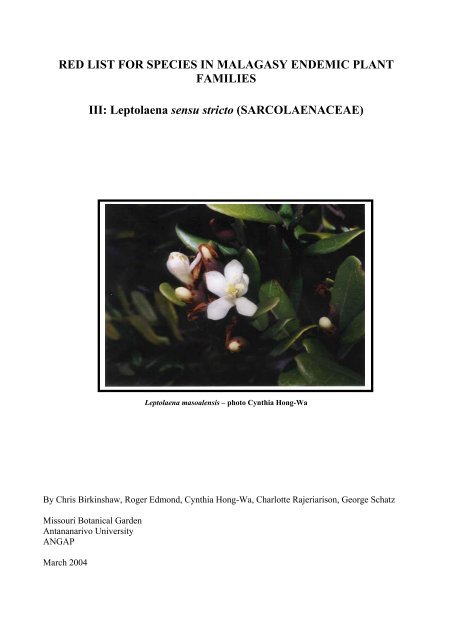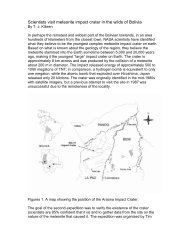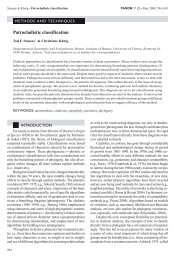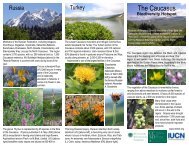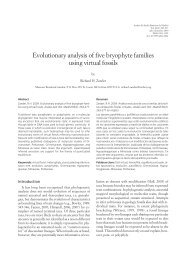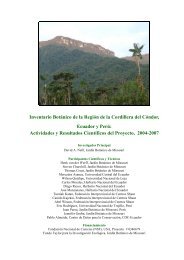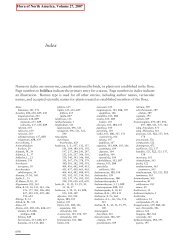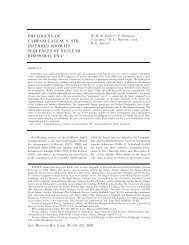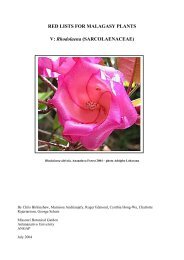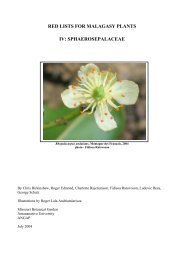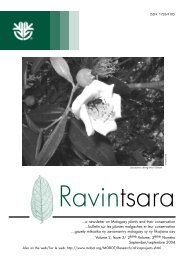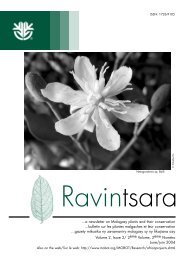red list for species in malagasy endemic plant - Missouri Botanical ...
red list for species in malagasy endemic plant - Missouri Botanical ...
red list for species in malagasy endemic plant - Missouri Botanical ...
Create successful ePaper yourself
Turn your PDF publications into a flip-book with our unique Google optimized e-Paper software.
RED LIST FOR SPECIES IN MALAGASY ENDEMIC PLANT<br />
FAMILIES<br />
III: Leptolaena sensu stricto (SARCOLAENACEAE)<br />
Leptolaena masoalensis – photo Cynthia Hong-Wa<br />
By Chris Birk<strong>in</strong>shaw, Roger Edmond, Cynthia Hong-Wa, Charlotte Rajeriarison, George Schatz<br />
<strong>Missouri</strong> <strong>Botanical</strong> Garden<br />
Antananarivo University<br />
ANGAP<br />
March 2004
Introduction<br />
Nowhere <strong>in</strong> the World can rival Madagascar <strong>in</strong> terms of the diversity and uniqueness of its flora.<br />
Estimates of the total number of <strong>plant</strong> <strong>species</strong> <strong>in</strong> the country cont<strong>in</strong>ue to climb and now it is thought<br />
that at least 13,000 <strong>species</strong> of higher <strong>plant</strong> grow <strong>in</strong> the country (pers. comm. P. Phillipson). This<br />
remarkable diversity is especially important given that nearly all these <strong>species</strong> (around 90% - Schatz<br />
1999) grow only <strong>in</strong> Madagascar. Sadly Madagascar’s exceptional flora is highly threatened and an<br />
alarm<strong>in</strong>g number of <strong>plant</strong> <strong>species</strong> are now on the very br<strong>in</strong>k of ext<strong>in</strong>ction. We must now choose<br />
whether to make strenuous ef<strong>for</strong>ts to conserve the Malagasy flora or accept, with<strong>in</strong> the next few<br />
decades, the loss of a large number of <strong>plant</strong> <strong>species</strong>. Now is the last chance to make this choice.<br />
An important part of effective conservation is prioritization: the relatively small amount of money<br />
available <strong>for</strong> conservation must be used where it will have most impact. To assist with the<br />
prioritization of conservation actions <strong>for</strong> the Malagasy flora a series of documents will be produced<br />
conta<strong>in</strong><strong>in</strong>g risk of ext<strong>in</strong>ction estimates <strong>for</strong> <strong>species</strong> <strong>in</strong> selected Malagasy <strong>plant</strong> families.<br />
The research presented here was conducted as a collaborative project between <strong>Missouri</strong> <strong>Botanical</strong><br />
Garden (MBG), Antananarivo University and Madagascar’s National Association <strong>for</strong> the<br />
Management of Protected Areas (ANGAP).<br />
Methods <strong>for</strong> estimat<strong>in</strong>g risk of ext<strong>in</strong>ction<br />
The identification of the <strong>species</strong> with the highest priority <strong>for</strong> conservation action is based on<br />
estimates of their likelihood of becom<strong>in</strong>g ext<strong>in</strong>ct <strong>in</strong> the next few decades. However be<strong>for</strong>e the risk<br />
of ext<strong>in</strong>ction of a <strong>species</strong> can be <strong>in</strong>vestigated it is necessary to ensure that it has been delimited<br />
us<strong>in</strong>g a taxonomic framework that closely reflects the real distribution of variation (that <strong>in</strong> turn<br />
reflects underly<strong>in</strong>g evolutionary history) with<strong>in</strong> the genus/family to which the <strong>species</strong> belongs. In<br />
an endeavor associated with our study the taxonomic framework of each of Madagascar’s <strong>endemic</strong><br />
families was exam<strong>in</strong>ed by scientists from <strong>Missouri</strong> <strong>Botanical</strong> Garden and the National Museum of<br />
Natural History <strong>in</strong> Paris .and those judged <strong>in</strong>adequate were revised. These revisions were published<br />
as a series of articles <strong>in</strong> the journal Adansonia and resulted <strong>in</strong> new <strong>species</strong> be<strong>in</strong>g delimited,<br />
previously recognized <strong>species</strong> be<strong>in</strong>g re-circumscribed, and others placed <strong>in</strong> synonymy.<br />
In<strong>for</strong>mation on the risk of ext<strong>in</strong>ction of each <strong>species</strong> was obta<strong>in</strong>ed from the analysis of its<br />
distribution and from observations made <strong>in</strong> the field. Most of this work was conducted by<br />
Malagasy students as part of their DEA (= Masters) studies. Species distribution was estimated<br />
us<strong>in</strong>g geo-referenced locality data obta<strong>in</strong>ed from herbarium specimens <strong>in</strong> the five herbaria (K, MO,<br />
P, TAN, TEF) with large hold<strong>in</strong>gs of Malagasy <strong>plant</strong>s. Most recent herbarium specimens <strong>in</strong>clude<br />
precise longitude and latitude coord<strong>in</strong>ates of the collection location obta<strong>in</strong>ed us<strong>in</strong>g a GPS, but many<br />
older specimens do not, necessitat<strong>in</strong>g post facto allocation of coord<strong>in</strong>ates by locat<strong>in</strong>g the collection<br />
site on maps with the aid of MBG’s Madagascar gazetteer (available on l<strong>in</strong>e at<br />
(http://www.mobot.org/MOBOT/Research/madagascar/gazetteer). The collection sites were<br />
mapped and analyzed us<strong>in</strong>g ArcView Geographic In<strong>for</strong>mation System (GIS) software. The<br />
resultant <strong>species</strong> distribution was quantified <strong>in</strong> terms of extent of occurrence, area of occupancy,<br />
and number of subpopulations. The analysis of each <strong>species</strong>’ distribution <strong>in</strong> relation to various<br />
environmental base maps provided <strong>in</strong><strong>for</strong>mation on the habitat of the <strong>species</strong> <strong>in</strong> terms of geology,<br />
vegetation type, bioclimate and elevation.<br />
In<strong>for</strong>mation on the habitat, abundance, poll<strong>in</strong>ation, seed dispersal, regeneration, threats, uses and<br />
vernacular name <strong>for</strong> each <strong>species</strong> was obta<strong>in</strong>ed by locat<strong>in</strong>g and study<strong>in</strong>g at least one population <strong>in</strong>
the wild. The best method of locat<strong>in</strong>g <strong>species</strong> proved to be with the assistance of local people liv<strong>in</strong>g<br />
close to previous collection sites. In<strong>for</strong>mation on the vernacular name and uses of the <strong>species</strong> were<br />
also obta<strong>in</strong>ed from the labels of herbarium specimens.<br />
Further <strong>in</strong><strong>for</strong>mation on the methods used <strong>in</strong> the study are provided <strong>in</strong> Table 1.<br />
The <strong>in</strong><strong>for</strong>mation collected <strong>for</strong> each <strong>species</strong> is summarized <strong>in</strong> a Risk of Ext<strong>in</strong>ction Datasheet
Table 1. Methods <strong>for</strong> the collection of <strong>in</strong><strong>for</strong>mation presented <strong>in</strong> each of the data fields of the Species<br />
Conservation Priority Datasheet.<br />
Species name and author: name of <strong>species</strong> accord<strong>in</strong>g to the most recent<br />
taxonomic revision and name of author(s) who def<strong>in</strong>ed the <strong>species</strong><br />
Vernacular names: from <strong>in</strong><strong>for</strong>mation collected <strong>in</strong> the field and captu<strong>red</strong><br />
from herbarium specimens.<br />
Description: based on <strong>in</strong><strong>for</strong>mation <strong>in</strong> the literature and our own<br />
observations of herbarium specimens and liv<strong>in</strong>g <strong>plant</strong>s <strong>in</strong> the field.<br />
Habitat:<br />
• Vegetation type: def<strong>in</strong>ed by observations <strong>in</strong> the field and analysis of the<br />
distribution of the <strong>species</strong> related to the vegetation map of DuPuy &<br />
Moat (1996)<br />
• Bioclimate: def<strong>in</strong>ed by the analysis of the distribution of the <strong>species</strong><br />
related to the bioclimate map of Cornet (1974)<br />
• Geology: def<strong>in</strong>ed by observations <strong>in</strong> the field and analysis of the<br />
distribution of the <strong>species</strong> related to the geology map of DuPuy & Moat<br />
(1996)<br />
• Altitude: based on field observations and <strong>in</strong><strong>for</strong>mation captu<strong>red</strong> from the<br />
notes accompany<strong>in</strong>g herbarium specimens<br />
Biology:<br />
• Poll<strong>in</strong>ation: probable poll<strong>in</strong>ator identified from characteristics of flower<br />
and observations <strong>in</strong> the field<br />
• Seed dispersal: probable method of seed dispersal identified from<br />
characteristics of fruit and observations <strong>in</strong> the field<br />
Uses: based on <strong>in</strong><strong>for</strong>mation collected by <strong>in</strong>terview<strong>in</strong>g local people <strong>in</strong> the<br />
field and captu<strong>red</strong> from the literature and notes on herbarium specimens.<br />
Distribution: distribution of the <strong>species</strong> represented by the<br />
locations of the collection sites of the herbarium specimens<br />
attributed to the <strong>species</strong> <strong>in</strong> the five herbaria with large<br />
collections from Madagascar. Map created us<strong>in</strong>g Arcview<br />
3.2 software.<br />
Herbarium specimens exam<strong>in</strong>ed: <strong>list</strong> of herbarium specimens exam<strong>in</strong>ed <strong>for</strong> this study<br />
Risk of ext<strong>in</strong>ction: based on the application of criteria presented<br />
<strong>in</strong> IUCN (2001)<br />
Conservation recommendations: our recommendations <strong>for</strong> actions to <strong>red</strong>uce the<br />
risk of ext<strong>in</strong>ction of the <strong>species</strong>.<br />
Observations of study population(s)<br />
Location: study site with geo-reference<br />
• Regeneration observed: presence of regeneration assumed from the presence at the<br />
site of <strong>in</strong>dividuals representative of all size classes.<br />
• Tolerant to disturbance: presence of regenerat<strong>in</strong>g populations of the <strong>species</strong> <strong>in</strong><br />
severely degraded vegetation ( >50% of orig<strong>in</strong>al biomass lost).<br />
• Density: average number of mature <strong>in</strong>dividuals of the <strong>species</strong> per ha of appropriate<br />
habitat based on counts <strong>in</strong> replicated plots or along transects.<br />
• Abundance: estimated number of mature <strong>in</strong>dividuals at the study site based on the<br />
density of the <strong>species</strong> at the site and an estimate of the area of suitable habitat<br />
available (abundance classes based on thresholds used <strong>in</strong> IUCN (2001).<br />
P<strong>red</strong>icted future decl<strong>in</strong>e:<br />
• Due to habitat loss: estimate of decl<strong>in</strong>e of population based on observations of<br />
tolerance of <strong>species</strong> to habitat perturbation and estimates of rate of loss of primary<br />
vegetation from (FAO 1993, Green & Sussman 1990, Ste<strong>in</strong><strong>in</strong>ger et al. 2002).<br />
Classes of population decl<strong>in</strong>e (i.e. 0-30%, ≥30-50%, ≥50-80%, ≥80%) relate to<br />
thresholds used <strong>in</strong> the IUCN (2001).<br />
• Due to exploitation or poor regeneration: <strong>in</strong> addition to loss of habitat it is possible<br />
that populations may decl<strong>in</strong>e because of selective exploitation or poor regeneration<br />
result<strong>in</strong>g <strong>for</strong> example from the <strong>in</strong>creas<strong>in</strong>g rarity of poll<strong>in</strong>ators or seed dispersers.<br />
Although we were unable to quantify these factors, their possible significance is<br />
noted.<br />
Distribution attributes <strong>for</strong> total population:<br />
(These analyses made us<strong>in</strong>g ArcVeiw 3.2)<br />
• Extent of occurrence: estimated as the area conta<strong>in</strong>ed with<strong>in</strong> the shortest<br />
cont<strong>in</strong>uous imag<strong>in</strong>ary boundary drawn to encompass all the collection locations <strong>for</strong><br />
the <strong>species</strong>.<br />
• Area of occupancy: estimated as the area of suitable habitat (def<strong>in</strong>ed <strong>in</strong> terms of<br />
vegetation type, bioclimate, altitude and geology) <strong>for</strong> the <strong>species</strong> with<strong>in</strong> the extent<br />
of occurrence.<br />
• Number of subpopulations: estimated as the number of collection locations but<br />
comb<strong>in</strong><strong>in</strong>g locations that are separated by less than 5 km.<br />
Representation <strong>in</strong> protected areas:<br />
Protected areas are def<strong>in</strong>ed as National Parks (PN), Special Reserves (RS), Nature<br />
Reserves (RNI), Biosphere Reserves (RB).<br />
• Number of subpopulations: number of data po<strong>in</strong>ts with<strong>in</strong> protected areas but<br />
comb<strong>in</strong><strong>in</strong>g locations separated by less than 5 km.<br />
• Protected areas: <strong>list</strong> of protected areas where the <strong>species</strong> has been recorded.
Endemic family with 8 genera and ca. 44 <strong>species</strong>.<br />
Sarcolaenaceae Caruel<br />
(from Schatz 2001)<br />
Hermaphrodite shrubs to large trees, often with stellate pubescence. Leaves alternate, simple,<br />
entire, penn<strong>in</strong>erved or rarely pseudo-tripl<strong>in</strong>erved by virtue of <strong>in</strong>duplicate vernation traces, with<br />
caducous stipules. Inflorescences umbelli<strong>for</strong>m or paniculate cymes, <strong>for</strong> sometimes flowers solitary,<br />
flowers small to often large and showy, regular, 5-merous, subtended by an <strong>in</strong>volucre of bracts<br />
wich are sometimes fused to <strong>for</strong>m a cup; sepals 3 (-5), imbricate; petals 5 (-6), free, or slightly fused<br />
at their base, twisted <strong>in</strong> bud; nectary disc present or not; stamens 5-numerous, sometimes slightly<br />
fused at their base <strong>in</strong>to 5 fascicles, filaments slender, anthers bilocular, longitud<strong>in</strong>ally dehiscent;<br />
ovary superior, 1-5-locular, style term<strong>in</strong>al, stigma 3-5-lobed; ovules 2-many per locule. Fruit a<br />
dehiscent capsule or <strong>in</strong>dehiscent and somewhat woody, often surrounded partially or completely by<br />
the <strong>in</strong>volucral bracts or cup; endosperm present.<br />
Key to genera of Sarcolaenaceae<br />
1. Leaves with longitud<strong>in</strong>al l<strong>in</strong>es (vernation traces) on either side of the midrib as a result of fold<strong>in</strong>g <strong>in</strong> bud,<br />
resembl<strong>in</strong>g ve<strong>in</strong>s and thus the venation superficially tripl<strong>in</strong>erved to 3-palmat<strong>in</strong>erved, rarely the traces absent<br />
(S. isaloensis) ......................................................................................................................Sarcolaena<br />
1'. Leaves lack<strong>in</strong>g vernation traces on either side of the midrib, never superficially tripl<strong>in</strong>erved or palmat<strong>in</strong>erved.<br />
2. Leaves with mixture of stellate and lepidote <strong>in</strong>dument, often dense; <strong>in</strong>volucre very small at anthesis, very late<br />
accrescent <strong>in</strong> fruit or not at all.<br />
3. Fruit <strong>in</strong>dehiscent, surrounded by accrescent, entire <strong>in</strong>volucre; ovary 2-locular ................Perrierodendron<br />
3'. Fruit dehiscent, the <strong>in</strong>volucre accrescent or not, lobed; ovary 3-5-locular.<br />
4. Sepals strongly unequal, the outer 2 much smaller; petals strongly contorted <strong>in</strong> bud; ovary 3-locular;<br />
ovules 2 per locule ..................................................................................................Eremolaena<br />
4'. Sepals more or less equal; petals slightly contorted <strong>in</strong> bud; ovary 5-locular; ovules 4-6 per locule<br />
................................................................................................................................Pentachlaena<br />
2'. Leaves glabrous or with simple <strong>in</strong>dument; <strong>in</strong>volucre well-developed at anthesis or not, accrescent <strong>in</strong> fruit.<br />
5. Flowers with <strong>in</strong>volucre well-developed at anthesis, deeply cup- or urn-shaped, partially or completely<br />
enclos<strong>in</strong>g the flower <strong>in</strong> bud.<br />
6. Involucre only partially enclos<strong>in</strong>g the flower <strong>in</strong> bud; stamens arranged <strong>in</strong> 5 fascicles; ovules many per<br />
locule; <strong>in</strong>volucre <strong>in</strong> fruit very large, bell-like, woody, narrowly ellipsoid, thick-walled, with a circular<br />
open<strong>in</strong>g at the apex, the fruit at the base .................................................................Xyloolaena<br />
6'. Involucre completely enclos<strong>in</strong>g the flower <strong>in</strong> bud; stamens not <strong>in</strong> fascicles; ovules 2 (-4) per locule;<br />
<strong>in</strong>volucre only slightly accrescent <strong>in</strong> fruit, not thick walled and bell-like with the fruit at the base<br />
................................................................................................................................Leptolaena (and<br />
Sarcolaena isaloensis)<br />
5'. Flowers with <strong>in</strong>volucre small at anthesis, not deeply cup- or urnshaped and partially or completely<br />
enclos<strong>in</strong>g the flower.<br />
7. Sepals 5, the outer 2 smaller; flowers large, pendulous, the petals showy p<strong>in</strong>k-violet <strong>for</strong>m<strong>in</strong>g a funnelshaped<br />
corolla; <strong>in</strong>volucre late accrescent <strong>in</strong> fruit, fleshy but not viscous, lobed but never sp<strong>in</strong>y<br />
................................................................................................................................Rhodolaena<br />
7'. Sepals 3; flowers small to large, petals white to cream-yellow, rarely p<strong>in</strong>k, spread<strong>in</strong>g, not <strong>for</strong>m<strong>in</strong>g a<br />
funnel-shaped corolla; <strong>in</strong>volucre strongly accrescent <strong>in</strong> fruit, viscous and fleshy, entire or lac<strong>in</strong>iate or<br />
with fleshy sp<strong>in</strong>es....................................................................................................Schizolaena
Leptolaena Thouars, Hist. Vég. Iles Austrl. Afriq.: 41. 1805.<br />
Shrubs to trees to 15 tall. Leaves often quite small, stipules fused or free, visible only on very<br />
young branches, cover<strong>in</strong>g the term<strong>in</strong>al bud. Inflorescences term<strong>in</strong>al cymes or panicles, flowers<br />
small; <strong>in</strong>volucre well-developed, cup-like, completely envelop<strong>in</strong>g the flower <strong>in</strong> bud, the rim<br />
toothed, becom<strong>in</strong>g fleshy to woody <strong>in</strong> fruit; sepals 3, persistent; petals 5, white; disc annular with<br />
toothed to crenulate marg<strong>in</strong>; stamens 10 (-15) to numerous; ovary 3-5-locular, style dist<strong>in</strong>ct, stigma<br />
3-5-lobed; ovules 2-3 per locule. Fruit tardily dehiscent 3-lobed capsule surrounded by fleshy to<br />
woody accrescent <strong>in</strong>volucre, with 1-3 seeds per locule.<br />
Leptolaena is distributed <strong>in</strong> humid to subhumid evergreen <strong>for</strong>est <strong>in</strong>clud<strong>in</strong>g the Sambirano region,<br />
from sea level to 1,500 m elevation, as well as dry semi-deciduous <strong>for</strong>est from the Ambongo-Bo<strong>in</strong>a<br />
region northwards. It is very closely related to Sarcolaena, with which it could well be merged. In<br />
general, Leptolaena can be dist<strong>in</strong>guished from Sarcolaena by smaller leaves that lack vernation<br />
traces, smaller flowers, and a drier, more woody <strong>in</strong>volucre <strong>in</strong> fruit.<br />
Vernacular names: aman<strong>in</strong>ombilahy, aman<strong>in</strong>ombilahy mena, anivorav<strong>in</strong>a, anjananjana, dilatra,<br />
fonto, fontona, foto, fotona, fotonalahy, fotondahy, haronganipanihy, hary, hazomasy, helana,<br />
kotika, laro, madiorano, marosirala, milaliambomad<strong>in</strong>ika, sarifatra, taimbarika, vandroza,<br />
vandrozana, vatsikana, voalaro, vondrozo, zahana, zana, zanalahy<br />
Leptolaena sensu stricto.<br />
Currently, the taxonomic framework <strong>for</strong> the Leptolaena-Sarcolaena complex is confused and<br />
<strong>species</strong> currently classified with<strong>in</strong> Leptolaena sensu lato (as def<strong>in</strong>ed by Cavaco 1952a, b) are<br />
probably polyphyletic. However, with<strong>in</strong> this taxa a sub-group of 8 <strong>species</strong>, classified <strong>in</strong> Leptolaena<br />
sensu stricto, are almost certa<strong>in</strong>ly monophyletic and have been made the subject of a recent<br />
taxonomic revision (Schatz et al. 2001): it is these that are <strong>in</strong>cluded <strong>in</strong> this Red List treatment. An<br />
estimation of the risk of ext<strong>in</strong>ction of the rema<strong>in</strong><strong>in</strong>g <strong>species</strong> currently classified as Leptolaena s.l.<br />
will be made once their taxonomy has been clarified.<br />
Species with<strong>in</strong> Leptolaena s.s. differ from other <strong>species</strong> of Leptolaena s.l. by their smaller flowers<br />
and smaller number of stamens.
Key to <strong>species</strong> of Leptolaena sensu stricto<br />
(from Schatz et al. 2001)<br />
1. Leaves small, the largest blades usually < 2 cm long (occasionally to 4.5 cm), broadly ovate to circular or rhombic;<br />
<strong>in</strong>florescences composed of 1-5 flowers..............................................................................................L. pauciflora<br />
1’. Leaves larger, the largest blade > 3 cm long, lanceolate, obovate or narrowly to broadly ovate or elliptic;<br />
<strong>in</strong>florescences composed of 7-50 flowers (2-8 L. masoalensis) ..........................................................2<br />
2. Leaf apex obtuse to rounded, sometimes emarg<strong>in</strong>ated ....................................................................3<br />
2’. Leaf apex acute to acum<strong>in</strong>ate. ........................................................................................................4<br />
3. Involucre urceolate, 3 mm tall, cove<strong>red</strong> with dense granular ferrug<strong>in</strong>ous <strong>in</strong>dumentum ; sepals exerted 1-1.5 mm<br />
beyond <strong>in</strong>volucre; leaves narrowly to broadly elliptic, secondary ve<strong>in</strong>s (8-)11-13 per side................L. delph<strong>in</strong>ensis<br />
3’. Involucre ellipsoid to oblong, 7 mm tall, cove<strong>red</strong> with sparse, short white <strong>in</strong>dumentum ; sepals completely <strong>in</strong>cluded<br />
with<strong>in</strong> <strong>in</strong>volucre; leaves elliptic to slightly obovate, secondary ve<strong>in</strong>s usually 8 per side....................L. masoalensis<br />
4. Leaves sparsely to moderately sericeous below, with both short appressed trichomes and longer slightly raised<br />
trichomes often exceed<strong>in</strong>g 1 mm long (older leaves occasionally subglabrous), marg<strong>in</strong>s dist<strong>in</strong>ctly revolute<br />
.............................................................................................................................................................L. raymondii<br />
4’. Leaves glabrous below or with <strong>in</strong>dumentum restricted to the midve<strong>in</strong>, marg<strong>in</strong>s weakly revolute to flat, sometimes<br />
m<strong>in</strong>utely thickened ..............................................................................................................................5<br />
5. Leaf blades with evident <strong>in</strong>dumentum on the midve<strong>in</strong> below .........................................................6<br />
5’. Leaf blades completely glabrous (rarely a few trichomes at the base of the midve<strong>in</strong> below) ........7<br />
6. Involucre usually < 3 mm tall, densely golden yellow granular far<strong>in</strong>ose, rounded at the base with a dist<strong>in</strong>ct peduncle 1<br />
mm long; petals 7-9 x 1-1.5 mm; leaves lanceolate to ovate, apex dist<strong>in</strong>ctly cuspidate......................L. cuspidata<br />
6’. Involucre 3-3.5 mm tall, densely ferrug<strong>in</strong>ous granular far<strong>in</strong>ose, usually also with slightly erect whitish trichomes 0.5<br />
mm long, especially <strong>in</strong> the lower portion, evenly taper<strong>in</strong>g to a cuneate base, with an <strong>in</strong>dist<strong>in</strong>ct peduncle
Leptolaena cuspidata – photo by Cynthia Hong-Wa Leptolaena masoalensis – photo by Cynthia Hong-Wa<br />
Leptolaena multiflora – photo Cynthia Hong-Wa Leptolaena pauciflora – photo Cynthia Hong-Wa<br />
Leptolaena raymondii – photo Cynthia Hong-Wa Leptolaena cuspidata fruits – photo Cynthia Hong-Wa
RISK OF EXTINCTION DATASHEETS
Leptolaena abrahamii G.E. Schatz & Lowry Risk of ext<strong>in</strong>ction: east Least Concern (although this <strong>species</strong><br />
has a high p<strong>red</strong>icted population decl<strong>in</strong>e it has several large and<br />
apparently secure sub-populations with<strong>in</strong> protected areas).<br />
Vernacular names : Anjananjana berav<strong>in</strong>a Conservation Recommendations: good management of<br />
protected areas<br />
Description:<br />
Medium tree. Leaf small (medium), lanceolate, strongly<br />
falcate, curved, asymmetrical, base acute/obtuse, apex<br />
acum<strong>in</strong>ate/cuspidate, papery, hairless when mature; petiole<br />
glabrous. Inflorescence with 6-23 flowers. Sepals equal to<br />
(or barely exceed) teeth of <strong>in</strong>volucre. Petals pale yellow.<br />
Flower stalk 1-1.5 mm. Fruit ovoid/globose, 2 mm longer<br />
than fleshy <strong>in</strong>volucre.<br />
Habitat<br />
• Vegetation type: mid-elevation evergreen <strong>for</strong>est<br />
• Bioclimate: humid, subhumid<br />
• Geology: basement rock<br />
• Altitude: 800-1,200 m<br />
Biology<br />
• Poll<strong>in</strong>ation: probably <strong>in</strong>sects (bees seen visit<strong>in</strong>g flowers at<br />
Sahamaloto))<br />
• Seed dispersal: probably birds and lemurs (at Sahamaloto<br />
fruits reported to be eaten by various birds (Hypsipetes<br />
madagascariesnsis, Treron australis) and Varecia<br />
variegata).<br />
Uses<br />
Timber (posts and house frames), bark used <strong>for</strong> manufacture<br />
of toaka gasy (alcoholic dr<strong>in</strong>k)<br />
Observations of study population(s):<br />
• Location: Sahamaloto (19°03’11’’S, 48°12’34’’E)<br />
Distribution<br />
• Regeneration observed: yes<br />
• Tolerant to disturbance: no<br />
• Abundance: 2,500-10,000 mature <strong>in</strong>dividuals<br />
P<strong>red</strong>icted future decl<strong>in</strong>e:<br />
• due to habitat loss : 50-80% (cause of loss = tavy)<br />
• because of exploitation or poor regeneration: decl<strong>in</strong>e possible<br />
because of selective exploitation <strong>for</strong> timber and <strong>red</strong>uction <strong>in</strong><br />
populations of possible seed dispersers and selective<br />
exploitation.<br />
Distribution attributes <strong>for</strong> total population:<br />
• Extent of occurrence: 10,080 km²<br />
• Area of occupancy: 3,329 km²<br />
• Number of subpopulations: 14<br />
Representation <strong>in</strong> protected areas:<br />
• Number of subpopulations: 3<br />
• Protected areas: Analamazaotra RS, Zahamena PN,<br />
Ranomafana PN<br />
Herbarium specimens exam<strong>in</strong>ed: Fianarantsoa: Ranomafana PN, SF(Rahahova) 14241, Ampas<strong>in</strong>ambo, SF 13718, Toamas<strong>in</strong>a: Ampasimpotsy,<br />
SF(Ratovoarison) 3497, Analamazaotra-Pér<strong>in</strong>et RS, Mamisoa N. Andrianjafy & Y.F. Razaf<strong>in</strong>drakoto 28, Analamazaotra-Per<strong>in</strong>et RS, James S. Miller, J.<br />
Brad<strong>for</strong>d, F. Rakotonasolo & A. Randrianasolo 8746, Farizana, SF(Pa<strong>in</strong>a) 5070 Per<strong>in</strong>et-Analamazaotra RS, SF(Ratovoarison) 14959, Per<strong>in</strong>et-Analamazaotra<br />
RS, SF(Ramaroson,A.) 6242, Sandrangato, SF(Rabenaivo,G.R.) 25441, Per<strong>in</strong>et-Analamazaotra RS, SF(Sampana,J.P.) 7564, [Sandrangato, SF(Ranaivojaona,N.)<br />
21898, Sandrangato, SF(Abraham) 21955, Per<strong>in</strong>et-Analamazaotra RS, SF(Station <strong>for</strong>estière d'Analamazaotra) 21244 , Antsahapandrano, SF(Ratovoarison)<br />
21282, Analamazaotra-Per<strong>in</strong>et RS, SF(Razafimandimby,M.) 10348, Ambatovy, Gordon McPherson 17523, Pér<strong>in</strong>et-Analamazoatra, G.E. Schatz & J.<br />
Rabenantoandro 3991, Pér<strong>in</strong>et-Analamazoatra, G.E. Schatz 3993, Analamazaotra-Per<strong>in</strong>et RS, M. Louvel 33, Ambatovy, Ph. Morat 3218, Zahamena RNI,<br />
RN(Botoal<strong>in</strong>a) 12684, Analamazaotra-Per<strong>in</strong>et RS, RN(Goulbert Andrianavo) 15, Analamazaotra-Per<strong>in</strong>et RS, SF 7509,Analamazaotra-Per<strong>in</strong>et RS, SF 3773,<br />
Nangarana, SF(9-R-FAO) 26927, Nangarana, SF(50-R-FAO) 26968, Analamazaotra-Per<strong>in</strong>et RS, R. Viguier & H. Humbert 851, Analamazaotra-Per<strong>in</strong>et RS, H.<br />
Perrier de la Bâthie 5336, Zahamena RNI, RN(Botoal<strong>in</strong>a) 3169, Pér<strong>in</strong>et-Anamalazaotra RS, Mabberley 813, Pér<strong>in</strong>et-Analamazaotra RS, SF 17932, Zahamena<br />
RNI, SF 26096, Zahamena RNI, RN (Laibosaka) 10953, Analamazaotra-Pér<strong>in</strong>et RS, SF(A. Fauchère) 12,, Bema<strong>in</strong>ty, G. Cours 4230, Nonokambo, (G. Cours)<br />
1206, Analamazaotra-Pér<strong>in</strong>et RS, E. Thouvenot (Ramanantoavolana) 12, Analamazaotra-Pér<strong>in</strong>et RS, SF(Ratovoarison F. d'Assise) 124-B-R-172<br />
Analamazaotra-Pér<strong>in</strong>et RS, SF(Ratovoarison F. d'Assise) 105-B-R-172, Zahamena, N.M. Andrianjafy et al. 255.
Leptolaena cuspidata Baker Risk of ext<strong>in</strong>ction: Least Concern (although this <strong>species</strong> is<br />
expected to decl<strong>in</strong>e it has several large and apparently secure<br />
sub-populations with<strong>in</strong> protected areas it is also somewhat<br />
tolerant to degradation of its habitat).<br />
Vernacular names : Zahana Conservation Recommendations: good management of<br />
protected areas<br />
Description:<br />
Shrub or small tree. Leaf small, lanceolate/ovale with<br />
rounded base and long cuspidate apex, papery, hairless at<br />
maturity, mid-rib evident on lower surface and cove<strong>red</strong> with<br />
small brown hairs, petiole hairy. Inflorescence with 14-27<br />
flowers. Flower stalk 1 mm. Involucre < 3 mm long, urnshaped,<br />
cove<strong>red</strong> with yellowish powder. Sepals exceed<br />
<strong>in</strong>volucre by 2 mm. Petals greenish white. Fruit ovoid and<br />
exceed<strong>in</strong>g fleshy <strong>in</strong>volucre by 1.5 mm.<br />
Habitat<br />
• Vegetation type: low-elevation evergreen <strong>for</strong>est, dry<br />
deciduous <strong>for</strong>est<br />
• Bioclimate: subhumid, dry<br />
• Geology: sandstone, lava, basement rocks, Mesozoic<br />
limestone, unconsolidated sands, alluvial and lake deposits<br />
• Altitude: 20-800 m<br />
Biology<br />
• Poll<strong>in</strong>ation: probably <strong>in</strong>sects (bees, beetles and butterflies<br />
seen visit<strong>in</strong>g the flowers at Analavory)<br />
• Seed dispersal: probably birds and lemurs (Hypsipetes<br />
madagascariensis, Treron australis and Eulemur macaco<br />
reported to eat fruit at Analavory)<br />
Uses<br />
Timber <strong>for</strong> construction, bark and leaves used <strong>for</strong> medic<strong>in</strong>e<br />
Distribution<br />
Observations of study population(s):<br />
• Location: Analavory (13°45’36’’S, 48°31’40’’E)<br />
• Regeneration observed: yes<br />
• Tolerant to disturbance: yes<br />
• Abundance: >10,000 mature <strong>in</strong>dividuals<br />
P<strong>red</strong>icted future decl<strong>in</strong>e:<br />
• because of habitat loss: 30-50% (cause of habitat loss = tavy)<br />
• because of exploitation or poor regeneration: decl<strong>in</strong>e possible<br />
because of <strong>in</strong>creas<strong>in</strong>g rarity of vertebrate dispersers and<br />
selective exploitation.<br />
Distribution attributes <strong>for</strong> total population:<br />
• Extent of occurrence: 12.319 km²<br />
• Area of occupancy: 2.571 km²<br />
• Number of subpopulations: 21<br />
Representation <strong>in</strong> protected areas:<br />
• Number of subpopulations: 3<br />
• Protected areas: Ankaranana RS, Manongarivo RS,<br />
Tsaratanana RNI<br />
Herbarium specimens exam<strong>in</strong>ed: Antsiranana: Antsatsaka, Chris Birk<strong>in</strong>shaw 1, Beramanja, Pete Phillipson 2017, Beramanja, SF(R. Capuron) 3078,<br />
Andilamboay, SF(Gachet) 3142, Tsaratanana RNI, SF(Gachet) 3171, Anjakely, SF(Petit-Marie,J.) 8225, Ambilobe, SF(Marohav<strong>in</strong>a) 10434, Manongarivo RS,<br />
SF(R. Capuron) 11486, Manongarivo RS, P. Derleth 89, Manongarivo RS, S. Totozafy Be 563, Ambato FC, H. Ravololonanahary et al. 37, Ampas<strong>in</strong>dava, J.<br />
Bosser 20152, Ambilobe, SERVICE FORESTIER 36016, Ambanja, R. Randrianaivo et al. 261, Ambohipiraka, H. Humbert & G. Cours 32873, Anjakely, SF<br />
12987 Ambohipiraka, G. Cours & H. Humbert 5674, Ambilobe, H. Humbert & R. Capuron 25580, Ankarana RS, H. Humbert & G. Cours 32649,<br />
Ambohipiraka, H. Perrier de la Bâthie 5340, Maromandia, H. Perrier de la Bâthie 3023, Ambanja, H. Perrier de la Bâthie 3021, Ambilobé, R. Decary 14775,<br />
Ambilobé, R. Decary 14794, Manongarivo RS, Stiefel, S.-L. 68, Andilamboay, SF(Gachet) 3141, Mahajanga, between Ambandamanga-Manambaliha and<br />
Ambodigavo, D. Baum 333
Leptolaena delph<strong>in</strong>ensis G.E. Schatz & Lowry Risk of ext<strong>in</strong>ction: Critically Endange<strong>red</strong> (A3c)<br />
Vernacular names : Fotona, Foto, Fotondahy Conservation Recommendations: a) <strong>in</strong>clusion <strong>in</strong> new<br />
protected area, b) use <strong>in</strong> restoration of land follow<strong>in</strong>g QMM<br />
m<strong>in</strong><strong>in</strong>g activities at Mandena<br />
Description:<br />
Medium tree. Leaf medium, elliptical/obovate with obtuse<br />
base and rounded/obtuse apex, edge slightly or strongly<br />
recurved, papery; petiole hairless. Inflorescence with 20-65<br />
flowers. Involucre urn-shaped, 3 mm long, densely cove<strong>red</strong><br />
with t<strong>in</strong>y brownish hairs. Sepals exceed<strong>in</strong>g <strong>in</strong>volucre by 1-<br />
1.5 mm. Petals white. Fruit globose and <strong>in</strong>cluded with<strong>in</strong><br />
<strong>in</strong>volucre.<br />
Habitat<br />
• Vegetation type: littoral <strong>for</strong>est<br />
• Bioclimate: Humid<br />
• Geology: unconsolidated sand, basement rock, alluvial and<br />
lake deposits<br />
• Altitude: 0-10 m<br />
Biology<br />
• Poll<strong>in</strong>ation: probably by <strong>in</strong>sects (bees, beetles and<br />
butterflies seen visit<strong>in</strong>g flowers at Mandena)<br />
• Seed dispersal: probably birds and lemurs (Cheirogaleus<br />
sp. reported to eat fruits at Mandena)<br />
Uses<br />
Timber <strong>for</strong> construction, bark used as a bitter<strong>in</strong>g agent <strong>in</strong><br />
toaka gasy (a locally-made alcoholic dr<strong>in</strong>k), exploited as fire<br />
wood.<br />
Distribution<br />
Observations of study population(s):<br />
• Location: Mandena (24°57’14’’S, 47°00’00’’E)<br />
• Regeneration observed: yes<br />
• Tolerant to disturbance: yes (abundant on degraded land)<br />
• Abundance: >10,000 mature <strong>in</strong>dividuals<br />
P<strong>red</strong>icted future decl<strong>in</strong>e:<br />
• because of habitat loss : >80% (reason <strong>for</strong> loss = tavy, burn<strong>in</strong>g,<br />
m<strong>in</strong><strong>in</strong>g)<br />
• because of exploitation or poor regeneration: decl<strong>in</strong>e possible<br />
because of <strong>in</strong>creas<strong>in</strong>g rarity of vertebrate dispersers and<br />
selective exploitation.<br />
Distribution attributes <strong>for</strong> total population:<br />
• Extent of occurrence: 221 km²<br />
• Area of occupancy: 14 km²<br />
• Number of subpopulations: 5<br />
Representation <strong>in</strong> protected areas:<br />
• Number of subpopulations: 0<br />
• Protected areas: none<br />
Herbarium specimens exam<strong>in</strong>ed: Toliara: Mandena SF, N. Dumetz 683, Mandena, G. McPherson & N. Dumetz 14665, Ste. Luce, G. McPherson, et<br />
al. 14835, Mandena, G. McPherson, et al. 14142, Ste. Luce, R. Rabevohitra 2053, Ste. Luce, G. McPherson, et al. 14222, Mandena, James L. Zarucchi et al.<br />
7504, Mandena SF, SF(Lamarque,P.) 8207, Mandena, SF(R. Capuron) 399, Mandena SF, SF(Ranjatson,E.) 14597, Mandena SF, W.G. Johnson WII 37,<br />
Mandena FC, Johny Rabenantoandro et al. 308, Manafiafy(=Sa<strong>in</strong>te Luce), SF(R. Capuron) 28656, Mandena SF, R. Rabevohitra et al. 3701, Mandena, J.<br />
Rabenantoandro et al. 271, Mandena, J. Rabenantoandro et al. 272, Mandena SF, R. Rabevohitra et al. 3671, Mandena SF, R. Rabevohitra et al. 3683,<br />
Mandromodromotra, R. Rabevohitra et al. 3739, Sa<strong>in</strong>te Luce, L. Fal<strong>in</strong>ia<strong>in</strong>a, J. Rabenantoandro & E. Ramisy 38, Mandena SF, H. Jacquem<strong>in</strong> 1149, Amb<strong>in</strong>anibe,<br />
, R. Decary 10064, Mandena, L. Fal<strong>in</strong>ia<strong>in</strong>a et al. 80, Mandena STF, Faly Randriantafika & E. Ramisy 261, Mandena STF, Faly Randriantafika, S.C. Hery & E.<br />
Ramisy 310
Leptolaena gautieri G.E. Schatz & Lowry Risk of ext<strong>in</strong>ction: Least Concern (although this <strong>species</strong> is<br />
expected to decl<strong>in</strong>e it has several large and apparently secure<br />
sub-populations with<strong>in</strong> protected areas).<br />
Vernacular names : Anjananjana Conservation Recommendations: Good management of<br />
protected areas<br />
Description:<br />
Medium tree. Leaves medium, ovate with rounded base and<br />
acute/acum<strong>in</strong>ate apex, papery, midve<strong>in</strong> hairy on lower<br />
surface of leaf; petiole hairy. Inflorescence with 8-29<br />
flowers. Involucre urn-shaped, 3-3.5 mm long, densely<br />
cove<strong>red</strong> with t<strong>in</strong>y <strong>red</strong>-brown hairs. Sepals exceed <strong>in</strong>volucre<br />
by 1.5 mm. Petals white. Fruit ovate/globose, entirely<br />
<strong>in</strong>cluded with<strong>in</strong> <strong>in</strong>volucre.<br />
Habitat<br />
• Vegetation type: mid-elevation evergreen <strong>for</strong>est<br />
• Bioclimate: humid, subhumid<br />
• Geology: basement rocks, ultrabasic rock, sandstones<br />
• Altitude: 300-1,250 m<br />
Biology<br />
• Poll<strong>in</strong>ation: probably by <strong>in</strong>sects (bees seen visit<strong>in</strong>g flowers<br />
at Ambatovy)<br />
• Seed dispersal: probably by birds and lemurs (Treron<br />
australis and Varecia variegata reported to eat fruits at<br />
Ambatovy).<br />
Uses<br />
Timber used <strong>for</strong> construction<br />
Distribution<br />
Observations of study population(s):<br />
• Location: Ambatovy (18°51’S, 48°18’E)<br />
• Regeneration observed: Yes<br />
• Tolerant to disturbance: No<br />
• Abundance: >10,000 mature <strong>in</strong>dividuals<br />
P<strong>red</strong>icted future decl<strong>in</strong>e:<br />
• because of habitat loss : 50-80% (tavy, m<strong>in</strong><strong>in</strong>g)<br />
• because of exploitation or poor regeneration: decl<strong>in</strong>e possible<br />
because of <strong>in</strong>creas<strong>in</strong>g rarity of vertebrate dispersers and<br />
selective exploitation.<br />
Distribution attributes <strong>for</strong> total population:<br />
• Extent of occurrence: 94.706 km²<br />
• Area of occupancy: 18.908 km²<br />
• Number of subpopulations: 11<br />
Representation <strong>in</strong> protected areas:<br />
• Number of subpopulations: 6<br />
• Protected areas: Manongarivo RS, Marojejy RNI, Tsaratanana<br />
RNI, Analamazaotra RS<br />
Herbarium specimens exam<strong>in</strong>ed: Antsiranana: Manongarivo RS, G.E. Schatz 3233, Marojejy RNI, A. Randrianasolo 307, Marojejy RN, A.<br />
Randrianasolo 325, Manongarivo RS, P.J. Rakotomalaza 48, Manongarivo RS, G. McPherson & H. van der Werff 16359, Manongarivo RS, G. McPherson & H.<br />
van der Werff 16396, Manongarivo RS, S. Malcomber & L. Rakotomalala 2608, Manongarivo RS, L. Gautier & S. T. Be 2920, Manongarivo RS, L. Gautier &<br />
C. Chatela<strong>in</strong> 2361, Manongarivo RS, L. Gautier, N. Messmer & F. Andriatsiferana 3510, Tsaratanana RNI, RN(Sajy) 2237, Tsaratanana RNI, Rakotozafy 336,<br />
Antongondriha, H. Humbert & R. Capuron 24147, Manongarivo RS, L. Gautier et C. Chatela<strong>in</strong> 2344 , Toamas<strong>in</strong>a: Mantady PN, Michel Randriambololona et al.<br />
17, Ambatovy, P.J. Rakotomalaza et al. 1279, Ambatovy, P.J. Rakotomalaza et al. 1286, Ambatovy, P.J. Rakotomalaza et al. 1309, Analamazaotra-Pér<strong>in</strong>et RS,<br />
Mamisoa N. Andrianjafy 31, Ambatovy, P.-J. Rakotomalaza et al. 1046, Ambatovy, Gordon McPherson 17467, Analamazaotra-Pér<strong>in</strong>et RS, J.-N. Labat et al.<br />
3068, Analamazaotra-Per<strong>in</strong>et RS, Toliara: Vohimavo, H. Humbert 20704
Leptolaena masoalensis G.E. Schatz & Lowry Risk of ext<strong>in</strong>ction: Critically Endange<strong>red</strong> (D)<br />
Vernacular names : Non rapporté Conservation Recommendations: a) <strong>in</strong>clusion of Ambato<br />
Massif <strong>in</strong>side Masoala PN, b) search <strong>for</strong> new populations, c)<br />
conservation ex-situ<br />
Description:<br />
Shrub. Leaf small, elliptic/obovate with symmetrical<br />
rounded/cuneate base and rounded apex, upper surface dark<br />
green, lower surface white-green, marg<strong>in</strong>s very revolute,<br />
leathery, hairless; petiole hairless. Inflorescence with 2-12<br />
flowers. Involucre ellipsoid/oblong, 7 mm long, with sparse<br />
white hairs. Sepals completly <strong>in</strong>cluded with<strong>in</strong> <strong>in</strong>volucre.<br />
Petals white. Fruit globose/ovoid, <strong>in</strong>cluded with<strong>in</strong> <strong>in</strong>volucre.<br />
Habitat<br />
• Vegetation type: low elevation evergreen <strong>for</strong>est, thicket<br />
• Bioclimate: humid<br />
• Geology: basement rock<br />
• Altitude: 380 m<br />
Biology<br />
• Poll<strong>in</strong>ation: probably <strong>in</strong>sects (no observations made but the<br />
floral characteristics and nature of visitors to the flowers of<br />
other <strong>species</strong> suggest <strong>in</strong>sect poll<strong>in</strong>ation).<br />
• Seed dispersal: probably by lemurs and birds<br />
Uses<br />
None known<br />
Distribution<br />
Herbarium specimens exam<strong>in</strong>ed: Antsiranana: Masoala PN, G. Rahajasoa, J. Rabe & R. Bernard 790<br />
Observations of study population(s):<br />
• Location: Ambato-Masoala (15°16’18’’S, 50°20’35’’E)<br />
• Regeneration observed: Yes<br />
• Tolerant to disturbance: No<br />
• Abundance:
Leptolaena multiflora Thouars Risk of ext<strong>in</strong>ction: Least Concern (although this <strong>species</strong> has a<br />
high p<strong>red</strong>icted population decl<strong>in</strong>e it has several apparently<br />
secure sub-populations with<strong>in</strong> protected areas).<br />
Vernacular names: Aman<strong>in</strong>aombilahy Conservation Recommendations: a) good management of<br />
protected areas, b) creation of new littoral <strong>for</strong>est protected areas<br />
Description:<br />
Medium (large) tree. Leaf blade medium (small), elliptic,<br />
somewhat falcate with acute apex, papery to leathery,<br />
hairless. Inflorescence with 9-47 flowers. Involucre urnshaped/cup-shaped.<br />
Sepals exceed<strong>in</strong>g <strong>in</strong>volucre by 1-1.8<br />
mm. Petals white. Fruit small, ovoid, entirely <strong>in</strong>cluded<br />
with<strong>in</strong> the <strong>in</strong>volucre.<br />
Habitat:<br />
• Vegetation type: littoral <strong>for</strong>est, low elevation evergreen<br />
<strong>for</strong>est<br />
• Bioclimate: humid<br />
• Geology: unconsolidated sand, lavas, alluvial and lake<br />
deposits, basement rocks<br />
• Altitude: 0-1,400 m<br />
Biology;<br />
• Poll<strong>in</strong>ation: probably by <strong>in</strong>sects (bees seen visit<strong>in</strong>g flowers<br />
at Mahatsara).<br />
• Seed dispersal: probably birds and lemurs (Hypsipetes<br />
madagascariensis and Hapalemurs griseus reported to eat<br />
fruit at Mahatsara)<br />
Uses: timber <strong>for</strong> construction and bark <strong>for</strong> medic<strong>in</strong>e<br />
Observations of study population(s)<br />
Distribution<br />
• Location 1: Mahatsara STF (17˚38’21”S, 49˚29’02”E)<br />
• Regeneration observed: yes<br />
• Tolerant to disturbance: yes<br />
• Abundance: 50-250 mature <strong>in</strong>dividuals<br />
• Location 2: Tampolo F.C. (49°24’, 17°16’)<br />
• Regeneration observed: yes<br />
• Tolerant to disturbance: yes<br />
• Abundance: 1000-2,500 mature <strong>in</strong>dividuals<br />
P<strong>red</strong>icted future decl<strong>in</strong>e:<br />
• because of habitat loss: 50-80% (cause of loss = tavy and fire)<br />
• because of exploitation or poor regeneration: decl<strong>in</strong>e possible<br />
because of <strong>in</strong>creas<strong>in</strong>g rarity of vertebrate dispersers and<br />
selective exploitation.<br />
Distribution attributes <strong>for</strong> total population<br />
• Extent of occurrence: 180 310 km²<br />
• Area of occupancy: 29 691 km²<br />
• Number of subpopulations: 42<br />
Representation <strong>in</strong> protected areas:<br />
• Number of subpopulations: 4<br />
• Protected areas: Masoala PN, Mananara RB, Manombo RS,<br />
Zahamena RN<br />
Herbarium specimens exam<strong>in</strong>ed: Antsiranana: [Masoala], SF(Roberson) 7494 .Masoala PN, G. Rahajasoa, R. Bernard & J. Rabe 424.Masoala PN, G.<br />
Rahajasoa, R. Bernard & J. Rabe 522.Masoala PN, Roger Bernard 372. Beankoraka, J. Rabe 157. Masoala RNI, RN(A.Tata) 2746. Masoala RNI, RN(Tsilizy)<br />
5514.Sahamalaza (Masoala), Service Forestier 34575. Masoala RNI, RN(P. Naivo) 9124 . Masoala RNI, RN (Ranjok<strong>in</strong>y) 9113 . Masoala RNI, RN (Ranjok<strong>in</strong>y)<br />
9310. Masoala RNI, RN(Zata) 3403 .Nosy-Be, Ch. d'Alleizette 268 . Andohan'Ifosa, R. Randrianaivo et al. 613, Ankarana, Lalao Jérémi Razafitsalama & R.<br />
Ludovic 28. Fianarantsoa : Manombo RS, SF(Girard) 15302 . Andrazaha, SF(Ratsirahonana) 15378 .Manombo SF, SF(Andriantsiferana,H.) 12929<br />
.Amporo<strong>for</strong>o, SF(Rakotomanana) 12401 Manombo SF, SF(Ratsimbazafy) 21493 . Amporofo, SF(Bora,Fl.) 13906 .Ifanirea, SF(Razanakolona) 14504<br />
Tohakandra, SF 3680 .Analavory, SF 15493 Evato, SF 16215 Ampangalana Atsimo, SF 19535 Ifanirea, SF 4813 Ampangalana Atsimo, SF 9501 Ambazato, SF<br />
16118 Misevo, Service Forestier 3809 Ifandana, R. Decary 5198 Mahabo, R. Rabevohitra & J. Rabenantoandro 3808 Manampano, SF(M. Jonarson) 89-R-303<br />
Vohitrakora, SF(A. Rakoto) 29-R-273 Mahabo, G. McPherson & J. Rabenantoandro 18317: Mahabo, Johny Rabenantoandro & G. McPherson 677. Toamas<strong>in</strong>a:<br />
Soanierano Ivongo, SF(Rakoto,J.D.) 2414: [Mananara RB, C. Birk<strong>in</strong>shaw et al. 354 Ambila Lemaitso SF, SF(Lemanivo) 1616 Foulpo<strong>in</strong>te, SF(Kiener,A.) 5677<br />
Vohibola, SF(R.Capuron) 18082 Tampolo SF, SF(Zavah,P.) 15215 Rantabe, SF(Ch. Randriamanga) 6252 Antetezana STF, SF(Todivelona) 7510 Tampolo SF,<br />
SF(Laisonoa) 10076 : Ambila-Lemaitso SF, SF(Andre) 21217 Tampolo SF, A. Randrianasolo 458 Tampolo STF, L.C. Raholivelo & G.E. Schatz 37 . Rantabe,<br />
N. Mamisoa Andrianjafy, F.Y. Razaf<strong>in</strong>drakoto & R. Jaovita 66 Tampolo SF, SF 10053 Tampolo SF, SF 16472Antetezana, SF 4679 Zahamena RN, RN(R.<br />
Laibosaka) 12429 Rantabe, SF(R.Capuron) 8901 Ambila-Lemaitso, SERVICE FORESTIER 29892 Mahatsara, SERVICE FORESTIER 32831 Tampolo SF, SF<br />
17820 Lakato, SERVICE FORESTIER 29717 Mahatsara, , SERVICE FORESTIER 34550 Mahatsara, SERVICE FORESTIER 35140 Tampolo SF, SERVICE<br />
FORESTIER 29860 Tampolo SF, SERVICE FORESTIER 19172 Ambila-Lemaitso SF, SF(L. Bégué) 745-R-1 Antetezana SF, SF(A. Kiener) 4-R-7 Tampolo<br />
SF, SF 19173 (P). Tamp<strong>in</strong>a, SF(Dumazer) s.n. Tamp<strong>in</strong>a, E. Ursch 116 Foulpo<strong>in</strong>te, L.-H. Boiv<strong>in</strong> s.n. Mahanoro, H. Perrier de la Báthie 14186 Mahatsara STF,<br />
Johny Rabenantoandro et al. 563 Tampolo STF, S.G. Razafimandimbison 150 .Tampolo STF, Johny Rabenantoandro et al. 536 . Tampolo STF, Richard<br />
Razakamalala et al. 142 Mahatsara STF, Richard Razakamalala et al. 151 Tampolo STF, Reza Ludovic & L.J. Razaf<strong>in</strong>tsalama 78 Antetezana STF, Reza Ludovic<br />
et al. 124 Tampolo STF, F. Y. Razaf<strong>in</strong>drakoto et al. 61
Leptolaena pauciflora Baker Risk of ext<strong>in</strong>ction: Least Concern (although this <strong>species</strong> has a<br />
high p<strong>red</strong>icted population decl<strong>in</strong>e it has several apparently<br />
secure sub-populations with<strong>in</strong> protected areas and is also<br />
somewhat tolerant of burn<strong>in</strong>g).<br />
Vernacular names : Fotona, Foto Conservation Recommendations: Good management of<br />
protected areas<br />
Description:<br />
Shrub. Leaves small, round/ovate with rounded base and<br />
obtuse apex, somewhat leathery, hairless at maturity; petiole<br />
with small hairs. Inflorescence with 10-30 flowers.<br />
Involucre with 1-5 flowers. Sepals exceed<strong>in</strong>g <strong>in</strong>volucre by<br />
1-1.5 mm. Petals green-white. Fruit ovoid, enclosed with<strong>in</strong><br />
<strong>in</strong>volucre.<br />
Habitat<br />
• Vegetation type: littoral <strong>for</strong>est, low and mid elevation<br />
evergreen <strong>for</strong>est<br />
• Bioclimate: humid, subhumid, dry<br />
• Geology: basement rocks, unconsolidated sands, lake and<br />
alluvial deposits, cipol<strong>in</strong>, quartzites, sandstones, lava<br />
• Altitude: 0-2300 m<br />
Biology<br />
• Poll<strong>in</strong>ation: probably <strong>in</strong>sects (bees seen visit<strong>in</strong>g flowers at<br />
Lakandava)<br />
• Seed dispersal: probably birds and lemurs (Foudia<br />
madagascariensis and Merops superciliosus reported or seen<br />
eat<strong>in</strong>g fruit at Lakandava – but neither of these <strong>species</strong> is<br />
normally conside<strong>red</strong> to be a seed disperser)<br />
Uses<br />
Roots used <strong>for</strong> beauty mask, bark used <strong>in</strong> the manufacture of<br />
toaka gasy (a locally-made alcoholic dr<strong>in</strong>k), fruit eaten, fire<br />
wood.<br />
Distribution<br />
Observations of study population(s):<br />
• Location: Lakandava (24°57’16’’S, 46°58’54’’E)<br />
• Regeneration observed: Yes<br />
• Tolerant to disturbance: somewhat tolerant of fire<br />
• Abundance: 50-250 mature <strong>in</strong>dividuals<br />
P<strong>red</strong>icted future decl<strong>in</strong>e:<br />
• because of habitat loss : 50-80% (cause of loss = tavy)<br />
• because of exploitation or poor regeneration: decl<strong>in</strong>e possible<br />
because of <strong>in</strong>creas<strong>in</strong>g rarity of vertebrate dispersers<br />
Distribution attributes <strong>for</strong> total population:<br />
• Extent of occurrence: 199.029 km²<br />
• Area of occupancy: 35.374 km²<br />
• Number of subpopulations: 84<br />
Representation <strong>in</strong> protected areas:<br />
• Number of subpopulations: 8<br />
• Protected areas: Ambohitantely RS, Andr<strong>in</strong>gitra RNI,<br />
Andohahela RNI, Analamazaotra RS, Manombo RS, Zahamena<br />
RNI
Herbarium specimens exam<strong>in</strong>ed: Antananarivo: Anjozorobe, D.K. Harder, M.C. Merello & S.G. Razafimandimbison 1536 Anjozorobe, G.E. Schatz,<br />
et al. 2961: Anjozorobe, P. P. Lowry II & J. Randrianasolo 4375 Anjozorobe, P. P. Lowry II & J. Randrianasolo 4397 Anjozorobe, James L. Zarucchi et al. 7345<br />
Anjozorobe A. Rakotozafy, P. Phillipson, S. Malcomber & S. Razafimandimbison 2682 Ambohitantely RS, SF 34023 Anjozorobe, R.E. Gereau, P.-J.<br />
Rakotomalaza, T. Razaf<strong>in</strong>drabeaza, G. Rafamatanatsoa & F. Andriatsiferana 5690 Anjozorobe, James S. Miller, J. Brad<strong>for</strong>d, F. Rakotonasolo & A.<br />
Randrianasolo 8777 Manankazo-Ankazobe SF SF(Ecol.Forest.) 16806 Ankafobe, G.E. Schatz, F.Y. Razaf<strong>in</strong>drakoto, N. M. Andrianjafy & J. Rabenantoandro<br />
3955 .Andranofeno-Sud, Mamisoa N. Andrianjafy et al. 11 Ambohitantely RS, Reserves Naturelles 6706: Sahatsio, H. Humbert 7111 Tampoketsa d'Ankazobe,<br />
J. Bosser 7944 Tampoketsa, J. Bosser 15978 Ambohitantely RS, G. Cremers 1624 Ambohitantely RS, G. Cremers 2020 Sahatsio, J. Bosser 9969 Col des Tapia,<br />
J. Bosser 18772 Ambohitantely RS, SERVICE FORESTIER 3-R-3 Ambohitantely RS, SERVICE FORESTIER 34202 Ambohitantely RS, Service Forestier<br />
19874: Ambohitantely RS, R. Randrianaivo et al. 75 Antsirabe, T.B. Croat 29218 Anjozorobe, A.J.M. Leeuwenberg & S.H.J.V. Rapanarivo 14648<br />
Ambohitantely RS, SF 9592 Ambohitantely RS, SF(R.Capuron) 8416: Tsitondro<strong>in</strong>a, H. Perrier de la Bâthie 13180 Anjozorobe, SF 15156 Ambohitantely RS, H.<br />
Humbert 11090 Ambohitantely RS, RN(Jean de Dieu) 168 Ambohitantely RS, RN(Jean de Dieu) 202 Manankazo, H. Perrier de la Bâthie 5337 Ibity, H. Perrier<br />
dela Bâthie 5341 Ibity, H. Perrier de la Bâthie 13574 Ankazobe, R. Decary 7302 Manankazo SF, R. Decary 17214 Tampoketsa d'Ankazobe, R. Decary 14927<br />
Ambohitantely RS, R. Decary 7473 Fianarantsoa: Ivato, A. Randrianasolo 232 Ambohimanjaky, , C.H. Jongk<strong>in</strong>d & Solo Rapanarivo 828 Ambohimanjaka, C.H.<br />
Jongk<strong>in</strong>d & Solo Rapanarivo 932 Ambohimanjaka, L.J. Dorr, L.C. Barnett, M.R. Cheek, A. Rakotozafy & N. Razafimalala 3842: Mont Ibity, L. Barnett 502<br />
Ampandrambato, SF(L.Bégué) 2708: between Ivato and Itremo, , Leeuwenberg, A.J.M. & G.R. Rafamantanantsoa 14443 Marohita, SF(Razafy,G.) 5631:<br />
Vohipaho, , SF(Tovolahy,A.) 5625: Ambohimanana, SF(Ranaivo,E.) 19695 Mananjary, SF(D<strong>in</strong>ard,A.) 7035 Misevo, [, SF(Randrianasolo,G.) 7292<br />
Ampangalana Atsimo, SF(Jonarson,M.) 13701 Itremo, , J. Rabenantoandro et al. 62: Itremo, N. Messmer & F. Andriatsiferana 781 Ambatof<strong>in</strong>andrahana, M.<br />
Keraudren-Aymon<strong>in</strong> & G. Aymon<strong>in</strong> 25712 Itremo, G.E. Schatz, F.Y. Razaf<strong>in</strong>drakoto, N.M. Andrianjafy & J. Rabenantoandro 3964 Ambohimanjaka, J.-N.<br />
Labat et al. 3010 Andr<strong>in</strong>gitra RN, RN(Rakoto J. de la C.) 6507 Ivato, Morat 3315: between Ivato and Ambatof<strong>in</strong>adrahana, G. Cremers 2052 Faliarivo, R. Decary<br />
14023 Mangatsiatra, SF 4829 Fiadanana, J. Peltier & M. Peltier 2159: Anjoma, J. Peltier & M. Peltier 2184: Anosivelo, SF 3811: Analalava, SF 14670<br />
Ankazondratana, SF 16113 Ankijana, SF 14763 Ankijana, SF 13472 Marohita, SF 9540 Antanambao, Service Forestier 14047 Nosy-Varika, SF 14661<br />
Androrangalava, SF 16119: Andr<strong>in</strong>gitra RNI, RN (Rakotovao) 7166 Andr<strong>in</strong>gitra RNI, RN (Rakotoson) 11691 Andr<strong>in</strong>gitra RNI, RN (Rakoto, J.C.) 706 Itremo,<br />
Croat, T.B. 29910 Mananjary, F. Geay 7707 Mananjary, F. Geay 8708: Mananjary, F. Geay 7926: Faliarivo, SF(R. Capuron) 11542 Ambatof<strong>in</strong>andrahana, R.<br />
Decary 13226 Ambatof<strong>in</strong>andrahana, H. Humbert & R. Capuron 28059 Itremo, H. Humbert 29938 Andr<strong>in</strong>gitra RNI, H. Perrier de la Bâthie 3004 Mananjary, F.<br />
Geay 7618 Mananjary, F. Geay 7507 Faliarivo, , H. Humbert 14477: Itremo, M. Keraudren-Aymon<strong>in</strong> & G.G. Aymon<strong>in</strong> 26009 Vatovavy, H. Perrier de la Bâthie<br />
4488 Ambila, H. Perrier de la Bâthie s.n. Ambatof<strong>in</strong>andrahana, H. Perrier de la Bâthie 3007 Matatana, H. Perrier de la Bâthie 3012 Ambositra, R. Decary 17403<br />
Ambositra, R. Decary 17311 Col des Tapia, H. Humbert & C.F. Sw<strong>in</strong>gle 4640: Faliarivo, R. Decary 14036 Ambatof<strong>in</strong>andrahana, R. Decary 13063:<br />
Ambatof<strong>in</strong>andrahana, R. Decary 17333 Itremo, SF 54-R-10 Mahabo, R. Rabevohitra & J. Rabenantoandro 3770 Mahabo, G. McPherson & J. Rabenantoandro<br />
18281 Mahajanga: Manandona, SF(R.Capuron) 232 Antsiasiaka, Ph. Morat 4512: Sahavoay, SF 15806: Beveromay, H. Perrier de la Bâthie 13213 Ilaka-Est, A.<br />
Randrianasolo 292 Toamas<strong>in</strong>a: Ambila-Lemaitso, G. E. Schatz & P. P. Lowry 1320 Ambila-Lemaitso, Pete Phillipson 1850: Ambila-Lemaitso, James L.<br />
Zarucchi et al. 7411 Ambila-Lemaitso, A. Randrianasolo 224 Ambila-Lemaitso SF, SF(Verdet) 3259 Mahanoro, SF(Tefamila) 3267 Ambila-Lemaitso, B. Lewis<br />
& S. Razafimandimbison 728 Ambila Lemaitso SF, SF(Ecol.Forest.) 1122 Ambila Lemaitso SF, SF(L.Bégué) 1569: Ambila-Lemaitso SF, SF(Verdet) 5737:<br />
Fierenana, SF(Abraham) 7598: Ambila-Lemaitso SF, SF(Andre) 7258 Ambila-Lemaitso SF, SF(Rakotozafy,Pau.) 13180: Ambila-Lemaitso SF, G. Cours 2981<br />
Ambila-Lemaitso SF, SF 4887 Marosiky, Ambila-Lemaitso SF, A.J.M. Leeuwenberg & R. Ranaivojaona 14589: Ambila-Lemaitso SF, SF 4157 Ambila-<br />
Lemaitso SF, SF 4711 Ambila-Lemaitso SF, SF 4908 Ambila-Lemaitso SF, SF 4707 Ampangalana Atsimo, SF 9506: Ambila-Lemaitso, SERVICE<br />
FORESTIER 32214: Ambila-Lemaitso SF, SF 9647 Iamboala, SF 19626 Didy, G. Cours 4646: Ambila-Lemaitso SF, R. Decary 6388: Ampasimpotsy SF, SF<br />
25366: Manohilahy, SF(R.Capuron) 18771: Ambila-Lemaitso SF, R. Decary 6502: Ambila-Lemaitso SF, RN(E. Rakoto) 1499 Zahamena RNI, RN(Rakotovao)<br />
11247:, Mahanoro, Perrier de la Bâthie 18120: Andranomandry, SF(J. P. Abraham) 25298: Brickaville, SF(J. P. Abraham) 30851: Antanambao (Tanambao),<br />
SF(R. Rabevohitra) 34662: Ambila - Lemaitso, SF(R. Rabevohitra) 29895: Ambila-Lemaitso, S.G. Razafimandimbison 179 . Zahamena PN, F. Ratovoson et al.<br />
524 Toliara: Andohahela RN, A. Randriamanantena & J. Durb<strong>in</strong> 119: Manantantely, A. Randrianasolo 283: Analalava, G. McPherson 14278: Evatra, R.E.<br />
Gereau, N. Dumetz, & R. Rabevohitra 3294 Ste. Luce, G. McPherson, et al. 14164: Andohahela RN, Beberonn Randriamampionona 331 Andohahela RN,<br />
Beberonn Randriamampionona 569: Andohahela RNI, Ph. Morat 4411 Mandena SF, SF(Lamarque,P.) 6077 Mandena SF, SF(Lamarque,P.) 7419: Mandena SF,<br />
SF(Rajaonarivelo,M.) 7820 Vatovary(=Vatovory), SF(Marlange) 12988 Mandromodromotra, SF(Rakotozafy,J.B.) 7771 Sa<strong>in</strong>te Luce (Manafiafy), A.<br />
Randrianasolo 347: Ampasimena, H. Humbert 20623: Vohimavo, H. Humbert 20702: [Mandena], Edmondson, N.Z. et al. 95-57: Fort-Dauph<strong>in</strong>, R. Decary 4038:<br />
Pic St Louis, J. Bosser 14138: Andohahela RNI, SF(R.Capuron) 22456: Mananten<strong>in</strong>a, , SF 9668: Andohahela RNI, RN(Randriamiera, H.) 13-RN-XI:<br />
Mahialambo, P. Boiteau 2568: Fort-Dauph<strong>in</strong>, M. Keraudren-Aymon<strong>in</strong> & G.G. Aymon<strong>in</strong> 24894: Pic Sa<strong>in</strong>t Louis, M. Keraudren 1062: Enivaha, H. Humbert<br />
5864: Mandena SF, W.G. Johnson WII 33: Fort Dauph<strong>in</strong>, G.F. Scott-Elliot 2369: Fort Dauph<strong>in</strong>, G.F. Scott-Elliot 2753: Fort Dauph<strong>in</strong>, G.F. Scott-Elliot 2554:<br />
Fort Dauph<strong>in</strong>, G.F. Scott-Elliot 2713bis: Fort Dauph<strong>in</strong>, M. Keraudren-Aymon<strong>in</strong> & G.G. Aymon<strong>in</strong> 24997 Mandromodromotra, H. Jacquem<strong>in</strong> 1158:<br />
Ambaravano, H. Jacquem<strong>in</strong> 934 Pic Sa<strong>in</strong>t Louis, R. Decary 10011: Pic St. Louis, H. Humbert 5899: Imonty, H. Humbert 14080: Andohahela RNI, H. Humbert<br />
13835: Mandena, Porter P. Lowry II, R. Rabevohitra & J. Rabenantoandro 5215 Mandena, Faly Randriantafika & G. Sehatrefy 247:
Leptolaena raymondii Schatz & Lowry Risk of ext<strong>in</strong>ction: Critically Endange<strong>red</strong> (A3, B1ab, B2ab,<br />
C2aii)<br />
Vernacular names: Aman<strong>in</strong>aombilahy Conservation Recommendations: a) good management of<br />
Mahatsara Forestry Station, <strong>in</strong> particular, protection of the site<br />
aga<strong>in</strong>st fire; b) re<strong>in</strong><strong>for</strong>cement of the population at Mahatsara and<br />
possible re<strong>in</strong>troduction to a neighbour<strong>in</strong>g site c) conservation<br />
ex-situ.<br />
Description:<br />
Small (medium) tree. Leaves small, ovate with acum<strong>in</strong>ate<br />
falcate apex, somewhat asymmetrical, long hairs on lower<br />
surface, marg<strong>in</strong> strongly revolute, papery; petiole with<br />
tomentum. Inflorescence with, 6-25 flowers. Involucre urnshaped.<br />
Petals white/pale yellow. Fruit globose, exceed<strong>in</strong>g<br />
the <strong>in</strong>volucre.<br />
Habitat<br />
• Vegetation type: littoral <strong>for</strong>est<br />
• Bioclimate: humid<br />
• Geology: unconsolidated sand<br />
• Altitude: 0-5 m<br />
Biology<br />
• Poll<strong>in</strong>ation: probably by <strong>in</strong>sects (bees, beetles, and hornets<br />
seen visit<strong>in</strong>g flowers at Mahatsara)<br />
• Seed dispersal: probably by birds and lemurs (no<br />
observations available but fruit characteristics and<br />
observations of animals eat<strong>in</strong>g the fruits of other Leptolaena<br />
<strong>species</strong> suggests <strong>species</strong> animal dispersed)<br />
Uses<br />
Timber used <strong>for</strong> construction and leaves used medic<strong>in</strong>ally.<br />
Distribution<br />
Observations of study population(s)<br />
• Location: Mahatsara STF (17˚38’21”S, 49˚29’02”E)<br />
• Regeneration observed: Yes<br />
• Tolerant to disturbance: No<br />
• Abundance: 50-250 mature <strong>in</strong>dividuals<br />
P<strong>red</strong>icted future decl<strong>in</strong>e:<br />
• because of habitat loss: > 80% (cause of habitat loss = fire)<br />
• because of exploitation or poor regeneration: decl<strong>in</strong>e possible<br />
because of <strong>in</strong>creas<strong>in</strong>g rarity of large vertebrate dispersers and<br />
selective exploitation.<br />
Distribution attributes <strong>for</strong> total population<br />
• Extent of occurrence: 0,17 km² (17 ha)<br />
• Area of occupancy: 0,17 km² (17 ha)<br />
• Number of subpopulations: 1<br />
Representation <strong>in</strong> protected areas:<br />
• Number of subpopulations: 0<br />
• Protected areas: none<br />
Herbarium specimens exam<strong>in</strong>ed: Toamas<strong>in</strong>a: Mahatsara, SF 34104 Mahatsara STF, Armand Randrianasolo & R. Ranaivojaona 638). Mahatsara STF,<br />
SF(Comtet) 34407 Mahatsara SF, SERVICE FORESTIER 35141. Mahatsara SF, SERVICE FORESTIER 34554. Mahatsara STF, SERVICE FORESTIER<br />
32648 Mahatsara STF, Johny Rabenantoandro et al. 562
References<br />
Cavaco A. (1952a). Recherches sur les Chlénacées, familles endémiques de Madagascar. Mém.<br />
Inst. Sci. Madagascar, sér. B Biol. Vég. 4: 59-92.<br />
Cavaco A. (1952b). Chlénacées. Flore de Madagascar 126: 1-37.<br />
Cornet A. (1974). Essai de Cartographie bioclimatique à Madagascar. ORSTOM, Paris.<br />
DuPuy D.J. & Moat J. (1996). A ref<strong>in</strong>ed classification of the primary vegetation of Madagascar<br />
based on underly<strong>in</strong>g geology: us<strong>in</strong>g GIS to map its distribution and to assess conservation stuatus.<br />
In Lourenco W.R. (Ed) Proceed<strong>in</strong>gs of the International Symposium on the biogeography of<br />
Madagascar: 205-218. ORSTOM, Paris.<br />
FAO (1993). Forest Resources assessment 1990. Tropical Countries. FAO Forestry Paper 112.<br />
Green G.M. and Sussman R.W. (1990). Science 248: 212-215.<br />
Hong-Wa C. (2003). Description, études écologiques, distribution, utilisation et risque d’ext<strong>in</strong>ction<br />
des espèces du genre Leptolaena Thouars sensu stricto (Sarcolaenaceae, Famille Endémique<br />
Malgache). Mémoire de DEA, University of Anananarivo, Madagascar.<br />
IUCN (2001). IUCN Red List Categories and Crtieria: Version 3.1. IUCN Species Survival<br />
Commission. IUCN, Gland Switerland.<br />
Schatz G.E. (2001). Generic Tree Flora of Madagascar. Royal Botanic Gardens, Kew and <strong>Missouri</strong><br />
<strong>Botanical</strong> Garden.<br />
Schatz G.E., Lowry P.P., and Wolf A-E. (2001). Endemic families of Madagascar VII. A synoptic<br />
revision of Leptolaena Thouars sensu stricto (Sarcolaenceae). Adansonia sér 3. 23(2): 171-189.<br />
Ste<strong>in</strong><strong>in</strong>ger M., Harper G., Juhn D., and Hawk<strong>in</strong>s F. (2002). Analyse de Changement de Couverture<br />
Forestière Nationale: 1990-2000. CI, CABS, NASA.


